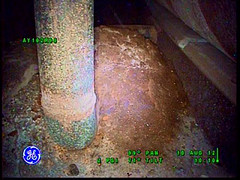In a recent post, Hanford 3 – New Problems, I talked about a lump of radioactive waste that had been found between the inner and outer shells of tank AY-102. There have been many DOE funded studies of the contents of that tank. Here are some of the findings.
Tank AY-102 is a second generation storage tank constructed with double-shell walls. It was designed to hold liquid waste generated by processing of uranium and other activities at the Hanford site. It contains 857,000 gallons of brown sludge in a translucent yellow liquid. The temperature of the tank range in temperature between 110° and 135° degrees.
The sludge inside the tank contains chunks of aluminum, nickel, lead, silver, copper, titanium, zinc and other common elements. In 2001, sodium hydroxide and sodium nitrate were added to the tank to prevent corrosion of the walls. The most common radioisotopes in the tank include:
Uranium 235 and 238 are most plentiful isotopes of uranium. Nuclear fuel and nuclear weapons are developed by processing the uranium to increase the percentage of U-235 which is more radioactive. Uranium is a toxic heavy metal like lead or mercury and is poisonous to human beings. Although most uranium that is inhaled or ingested is excreted by the human body in a matter of days, a small amount will be deposited in the bones where it will stay for years where it may cause cancer.
Plutonium 238, 239, 240 and 241 are generated by neutron absorption by nuclides such as U-238 and Np-237. It is a toxic heavy metal and poisonous to human beings. It is also highly radioactive and can cause cancer if ingested or inhaled.
Strontium-90 chemically resembles calcium and is taken up by the bones if ingested and can cause bone cancer.
Cesium137 is one of the primary components of the Fukushima fallout. It spreads through the soft tissue of the body and can cause a variety of cancers.
Thorium is a naturally occurring radioactive element that has been proposed as an safer alternative to uranium for nuclear fuel because it isn’t useful for making nuclear weapons. If it is inhaled or ingested it can cause lung cancer, pancreatic cancer or bone cancer.
Carbon-14 is present in all living beings and is not considered particularly dangerous.
Cobalt-60 is one of the radioisotopes widely used in nuclear medicine. It can cause cancer.
Selenium-79, technetium, antimony, neptunium-237, americium-241 and curium 243 and 244. Some of these isotopes are used in industry or medicine but have their own health dangers.
The solid lump found in tank AY-102 between the inner and outer shells is currently being analyzed to determine exactly what it contains and where it came from. The great concern is that it may have leaked from tank AV-102. If this is the case, then the double-shelled tanks are not stable and safe for storing nuclear waste while a permanent solution is found.
Solid lump in tank AY-102:
